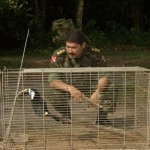(Editor’s Note: This story was originally published March 23, 2010)
Animals seized from Brazilian jungles by wildlife traffickers, then confiscated by well-meaning officials and animal rights activists, frequently face even more problems than they had before, says a biologist from the University of São Paulo.

Juliana Machado Ferreira
Biologist Juliana Machado Ferreira, who is pursuing her doctorate in Conservation Genetics at the Laboratory of Evolutionary Biology and Vertebrate Conservation, said in a speech in the U.S. last February that the animals’ troubles may have just begun.
“People say ‘Yay!’ The good guys arrived and took the cute, mistreated animals from the evil traffickers and everyone lives happily ever after,” she said in a five-minute presentation at the TED Conference in Long Beach, Calif. (Speech below.)

(Courtesy Smithsonian.com)
“But these days, no. This is where many of our problems begin because we have to figure out what to do with all these animals. In Brazil, they are first sent to governmental triage facilities, which in most cases, the conditions are just as bad as with the traffickers.”
She said an estimated 38 million animals are trafficked each year in Brazil, fueling a $2 billion pets market just to São Paulo and Rio de Janeiro alone.
In 2002, she said, the “good guys” recaptured 45,000 animals, 37,000 of them birds, representing just five percent of what had been trafficked.
Worldwide, according to a 2009 report in Smithsonian Magazine that cites U.S. State Department figures, wildlife trafficking is thought to be the third most valuable illicit commerce in the world, after drugs and weapons, worth an estimated $10 billion a year. Birds are the most common contraband; the State Department estimates that two million to five million wild birds, from hummingbirds to parrots to harpy eagles, are traded illegally worldwide every year. Millions of turtles, crocodiles, snakes and other reptiles are also trafficked, as well as mammals and insects.

Ferreira
Ferreira said the recaptured birds frequently face death at the hands of the very people who saved them.
“The Brazil Ornithological Society claims we have too little knowledge about these species in nature, and that it would be too risky to release these animals. They also claim we spend too many resources o

(Courtesy BBC)
n rehabilitation. They suggest all birds seized from non-threatened species should be euthanized.
“That would mean having killed 26,267 birds only in the state of São Paulo, and only in 2006.”
She said she is leading a research team in rehabilitating the rehabilitators.
“Technically responsible releases are possible,” she said, “both for the well being of the individual and for the conservation of their species.”
She exhorted the audience, “Let’s study more, and shed light on this issue.”
VIDEO: Juliana Machado Ferreira at the TED Conference, Long Beach, Calif., February 2010
VIDEO: Illegally traded wild animals seizure operation with the Civil Police of São Paulo and Juliana M. Ferreira
Citations:
The fight to end rare-animal trafficking in Brazil
Ted.com, March 23, 2010
Wildlife Trafficking
Smithsonian Magazine Dec. 2009
It’s sad to read that so many of the “saved” birds are in danger. The biggest concern seems to be that owners who adopt animals are uneducated. And as a result, the animals suffer. Priorities should be to teach future owners how to properly take care of these animals.
Louis Slade
Email Marketing Company